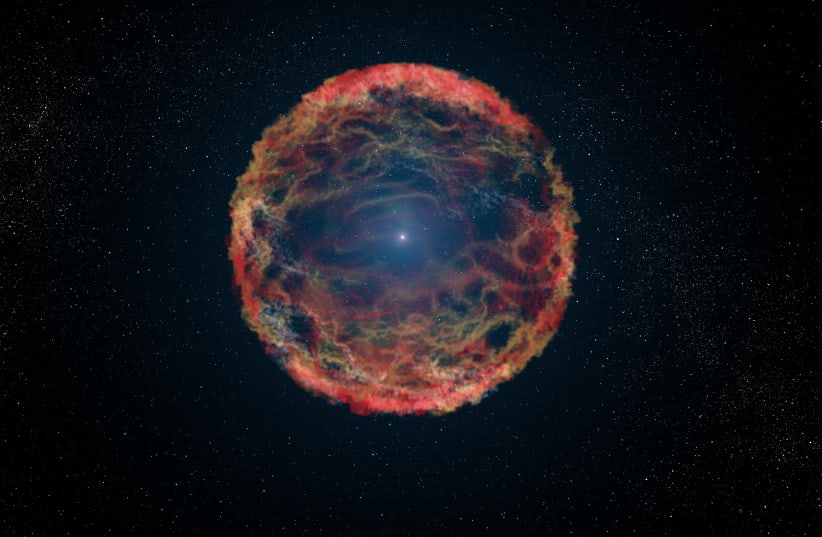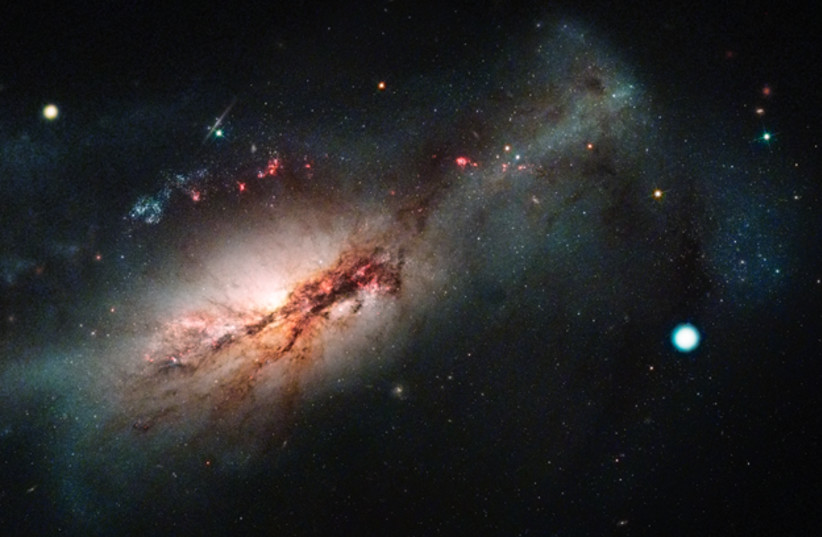The year 2022 is starting off with a bang with this massive supernova.
Scientists at Israel’s Weizmann Institute of Science in Rehovot have managed to witness the explosion of a massive Wolf-Rayet star, a supernova hypothesized by many scientists that should have been impossible.
This observation, detailed in a study published in the peer-reviewed academic journal Nature, gave proof to something that had only existed thus far as a theory and had never been seen before.
What is a supernova?
A supernova is essentially an exploding star. It is one of the two fates for a star when it reaches the end of its life cycle, no longer able to produce energy in its core.
Stars of all kinds are fueled by this energy production in their cores, which sees energy made by nuclear fission fusing lighter elements to form heavier ones. It is this process that keeps the star hot, allowing gases to expand while simultaneously drawing its mass toward the core in a delicate gravitational balance.
When a star can no longer produce this energy, a process that takes millions or billions of years, one of two things happen. In the case of stars around the size of our Sun or smaller, it will result in the star collapsing to form a white dwarf.
But for stars large enough, around eight-15 solar masses at a minimum, it causes a supernova, which sees the heavy elements blasted throughout space in an explosive display. This in turn results in several outcomes for these elements and the rest of the universe. For the progenitor star itself, however, it results in generally one of two outcomes: Either it is completely destroyed, or it collapses in on itself to form a neutron star (if the original star was big enough) or a black hole.
Black holes are a perplexing astronomical phenomenon in their own right, but supernovas, once considered extremely rare occurrences for scholars to witness, have become better understood as time and scientific progress marched on.
Weizmann’s Particle Physics Faculty dean Prof. Avishay Gal-Yam, the study leader, had located seven supernovas in four years when he was a doctoral student. Today, however, with the right tools and methodology, it is possible to detect 50 supernovae a day.
And yet, there were still some mysteries, specifically regarding some massive stars.
There are several different types of stars that exist, and they vary in terms of brightness, size and lifespan. Stars like our Sun, for example, have a life expectancy of around 10 billion years. Massive stars, however, last just a few million years.
One type of these massive stars is the Wolf-Rayet star. These rare large stellar bodies differ from other stars in a few ways, most notably in that one or more external layers of lighter elements are missing. This is notable, as due to the way nuclear fission stratified the elements in a star, the outer layers are usually composed of lighter elements while the heavier ones are concentrated toward the core.
Normally, the outermost external layers would be filled with hydrogen, the lightest element. However, in Wolf-Rayet stars, this is not the case. Rather, the outermost layers contain helium or even carbon and other heavier elements.
It is unknown exactly why this is, though theories do exist, one of the most notable being that strong stellar winds essentially remove the lighter layers one at a time over the course of several hundred thousand years. This in turn gives them the appearance of decaying, of progressive disintegration over a long period of time.
Despite their short lifespan, there has never once been a definitive observation of a Wolf-Rayet star going supernova. It was theorized that they could exist, though. In fact, certain types of supernovae were suspected to have originated in Wolf-Rayet stars, though this had never been proven. Many scientists ended up suspecting that due to Wolf-Rayet stars never having been detected as ever-going supernovae, they may not do so at all. Rather, they may end up just quietly collapsing into a black hole without producing any visible explosion at all.
But Gal-Yam and his team have proven this assumption to be false, having done what astronomers around the world had long failed to do: find a supernova originating from a Wolf-Rayet star.
This was done through the use of analyzing the light emitted by the supernova explosion. By using a spectroscopic analysis to study the electromagnetic wavelengths of the explosion, it is possible for scientists to identify signatures associated with certain elements that are being propelled by the explosion.
Overall, the team identified a few elements such as carbon and oxygen – both of which are expected in a supernova. But the team also found another element that had never been seen in a supernova before in this manner: Neon, something already scarce in the solar system, though on a universal scale very abundant.
In addition, they also came to the conclusion that the materials spouting radiation were in the space surrounding the star, not participating in it.
What is the significance of these findings?
According to Gal-Yam, it seems to support the hypothesis about how the outer layers of Wolf-Rayet stars are stripped away.
But since this is the first discovery of its kind, it may be too early to say for sure if this is how all Wolf-Rayet stars go supernova like this.
“We can’t say at this stage whether all Wolf-Rayet stars end their lives with a bang or not. It might be that some of them do collapse quietly into a black hole,” the professor said in a statement.
However, it is clear that despite this massive explosion, not all of the matter from the star was actually there.
“We estimate that the mass that dispersed during the explosion is probably equal to that of the Sun or a slightly smaller star; the star that exploded was significantly heavier – having a mass at least 10 times greater than that of the Sun. So where did the majority of mass end up?”
There is one possibility: The supernova blasted some mass into space, but the rest formed a black hole. But while the black hole can’t be confirmed, the supernova itself can be.
“One thing’s certain,” says Gal-Yam, “This is not the ‘silent’ collapse often referred to in the past. It is worth mentioning that since this discovery was first made, another similar explosion of a Wolf-Rayet star has been observed, implying that this phenomenon is indeed not a single occurrence. It is possible that the better our detection and measurement instruments become, the more this type of explosion – today considered rare and exotic – will become a common sight.”
This discovery, though, isn’t the only recent major observation of a supernova. A new observation by scientists using the Pan-STARRS telescope in Hawaii managed to recently observe a red supergiant star known as SN 2020tlf going supernova, witnessing the process before, during and after the massive explosion.
These findings have more implications than might first be evident. Supernovae are not mere explosions; they are vital functions in the universe that play essential roles in the workings of the cosmos.
The spreading of materials by supernovae are essentially the building blocks for the births of new stars and planets. It is this that led to the creation of our solar system and, indeed, our very planet and all the life forms that live on it.
“We study the origins of all matter, including that found on Earth, and search for explanations of many of the physical phenomena we tend to take for granted,” concludes Gal-Yam. “This is what I am personally interested in – where did all of this come from? – and I want to be able to answer this question as best and as accurately as I can.”

